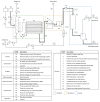Spray Drying Is a Viable Technology for the Preservation of Recombinant Proteins in Microalgae
- PMID: 36838478
- PMCID: PMC9967251
- DOI: 10.3390/microorganisms11020512
Spray Drying Is a Viable Technology for the Preservation of Recombinant Proteins in Microalgae
Abstract
Microalgae are promising host organisms for the production of encapsulated recombinant proteins such as vaccines. However, bottlenecks in bioprocess development, such as the drying stage, need to be addressed to ensure feasibility at scale. In this study, we investigated the potential of spray drying to produce a recombinant vaccine in microalgae. A transformant line of Chlamydomonas reinhardtii carrying a subunit vaccine against salmonid alphavirus was created via chloroplast engineering. The integrity of the recombinant protein after spray drying and its stability after 27 months storage at -80 °C, +4 °C and room temperature were assessed by immunoblotting. The protein withstood spray drying without significant losses. Long-term storage at +4 °C and room temperature resulted in 50% and 92% degradation, respectively. Optimizing spray drying and storage conditions should minimize degradation and favour short-term storage at positive temperatures. Using data on yield and productivity, the economics of spray drying- and freeze drying-based bioprocesses were compared. The drying stage corresponded to 41% of the total production cost. Process optimization, genetic engineering and new market strategies were identified as potential targets for cost reduction. Overall, this study successfully demonstrates the suitability of spray drying as a process option for recombinant protein production in microalgae at the industrial scale.
Keywords: Chlamydomonas reinhardtii; microalgae; oral vaccination; recombinant protein; scale-up; spray drying; techno-economic analysis.
Conflict of interest statement
The authors declare no conflict of interest.
Figures







Similar articles
-
Influence of drying and storage on lipid and carotenoid stability of the microalga Phaeodactylum tricornutum.J Agric Food Chem. 2011 Oct 26;59(20):11063-9. doi: 10.1021/jf2025456. Epub 2011 Sep 28. J Agric Food Chem. 2011. PMID: 21866882
-
Stabilization of HAC1 influenza vaccine by spray drying: formulation development and process scale-up.Pharm Res. 2014 Nov;31(11):3006-18. doi: 10.1007/s11095-014-1394-3. Epub 2014 May 24. Pharm Res. 2014. PMID: 24858396
-
Techno-economic assessment of microalgae production, harvesting and drying for food, feed, cosmetics, and agriculture.Sci Total Environ. 2022 Sep 1;837:155742. doi: 10.1016/j.scitotenv.2022.155742. Epub 2022 May 6. Sci Total Environ. 2022. PMID: 35526636
-
Improving the drying of Propionibacterium freudenreichii starter cultures.Appl Microbiol Biotechnol. 2021 May;105(9):3485-3494. doi: 10.1007/s00253-021-11273-3. Epub 2021 Apr 22. Appl Microbiol Biotechnol. 2021. PMID: 33885925 Review.
-
Spray Drying and Particle Engineering in Dosage Form Design for Global Vaccines.J Aerosol Med Pulm Drug Deliv. 2022 Jun;35(3):121-138. doi: 10.1089/jamp.2021.0056. Epub 2022 Feb 16. J Aerosol Med Pulm Drug Deliv. 2022. PMID: 35172104 Review.
Cited by
-
Transgenic Microalgae Expressing Double-Stranded RNA as Potential Feed Supplements for Controlling White Spot Syndrome in Shrimp Aquaculture.Microorganisms. 2023 Jul 26;11(8):1893. doi: 10.3390/microorganisms11081893. Microorganisms. 2023. PMID: 37630453 Free PMC article.
-
Kinetic study and modelling of drying of Chlorella vulgaris.Heliyon. 2024 Sep 26;10(19):e38441. doi: 10.1016/j.heliyon.2024.e38441. eCollection 2024 Oct 15. Heliyon. 2024. PMID: 39403521 Free PMC article.
-
Algae Protein Creates Sustainable Alternatives for Various Food Matrices: From Function to Nutrition.Compr Rev Food Sci Food Saf. 2025 Sep;24(5):e70264. doi: 10.1111/1541-4337.70264. Compr Rev Food Sci Food Saf. 2025. PMID: 40844019 Free PMC article. Review.
-
The Clinical Promise of Microalgae in Rheumatoid Arthritis: From Natural Compounds to Recombinant Therapeutics.Mar Drugs. 2023 Dec 7;21(12):630. doi: 10.3390/md21120630. Mar Drugs. 2023. PMID: 38132951 Free PMC article. Review.
References
-
- FAO . The State of World Fisheries and Aquaculture 2020. Sustainability in Action. FAO; Rome, Italy: 2020. - DOI
-
- Wesolowska A., Ljunggren M.K., Jedlina L., Basalaj K., Legocki A., Wedrychowicz H., Kesik-Brodacka M. A Preliminary Study of a Lettuce-Based Edible Vaccine Expressing the Cysteine Proteinase of Fasciola Hepatica for Fasciolosis Control in Livestock. Front. Immunol. 2018;9:2592. doi: 10.3389/fimmu.2018.02592. - DOI - PMC - PubMed
Grants and funding
LinkOut - more resources
Full Text Sources

